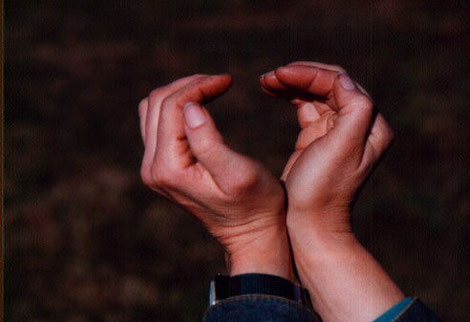Exploration TTouch

Is your horse difficult under saddle? Is he out of balance or resistant to certain movements? Does he spook, not pay attention or does he just feel stiff? Here is an excellent way to pinpoint whether or not his behavior is being caused by discomfort in his body. It is time to do some exploring.
Before you use the "Exploration TTouch" it is important to check your horse's body carefully. To begin, stand your horse on a firm, level surface. Position him so he is standing square. If you horse does not want to stand square or has a habit of always standing out of balance or resting one hind leg, he is already telling you something. It may be uncomfortable for him to stand normally in good balance, or he may be physically out of balance due to a structural problem.
Have someone hold your horse while you run your hands over his body, noting the feeling under you hand and your horse's reaction to it. Does your horse flinch, or show concern? Is one area unusually hot or cold? Now look for asymmetry. Stand directly in front of your horse and compare the muscle development of his shoulders, chest and forearms. Do your horse's right and left sides match? Are the knobs on the insides of his knees even? Are his coronary bands level? Are his hooves of equal size?
Now stand directly behind your horse on a stool (if you can do this safely) and sight down your horse's back. Is his spine straight? Is the muscling on either side of it symmetrical? Look closely at the muscling on either side of the wither area (you may have to move the mane out of the way). There are often asymmetries here. Step down then and move your horse's tail out of the way or tie it up in a knot. Does the muscling of each of his hind legs match? Is his tail straight? Your observations may give you a clue as to why your horse is behaving in a certain way. If your horse has trouble picking up a particular lead could it be because he lacks muscle in one shoulder? If he is "cold backed" could it have something to do with the lack of straightness you observed in his spine?
Now you are ready to begin the Exploration TTouch (also called the "Bear" TTouch). A word of caution here--use common sense! If your horse has any tendency to bite, kick or strike, proceed carefully with the Exploration TTouch. If your horse has a strong reaction, either lighten the pressure you are using or stop. To begin, stand to one side of your horse's head, facing the rear. Place one hand on either side of his neck just behind his ears. Use curved fingers to press straight into the muscles of his neck. Press in with both hands simultaneously. Press in enough to depress the skin about half an inch. Each "press and release" should last less than one second. Press and release once and then move your fingers down the center of the neck pressing and releasing about every four inches until you come to the shoulder.
Then drop your hands down just behind the point of the shoulder and press and release in a straight line back to the girth area. Next, start on either side of the withers and go all the way back to the tail, pressing and releasing about four inches to either side of the spine.
This is a check for pain or sensitivity. A normal or pain-free horse should have little or no reaction to this probing. A sensitive or sore horse will object. Keep in mind that thinly muscled horses will tend to be more sensitive than those who are heavily muscled. Many, many horses will react especially in the poll or neck area. Some horses who show a strong reaction to the first few touches may merely be surprised, and may not react later. If your horse has an extreme reaction, especially more than once, think twice about continuing. At least switch to a different part of the body before continuing.
Extreme reactions in the neck area are not uncommon. Soreness here often results when horses pull back while tied which can cause subluxated vertebra. Flinches in the wither area usually indicate that the saddle pinches or there has been trauma to the withers. Dropping the back or tiny spasms in the muscles here are an indication of a sore back. There are many causes of back pain including bouncing riders and ill-fitting saddles. Reactions in the croup and buttock area are often seen in horses who are very resistant under saddle, who spook a lot and are afraid of things behind them. Slipping and falling are just some of the things that result in pain and tightness here.
While the TTouches, leg circles and neck flexions a TTEAM practitioner may do will definitely help to alleviate soreness in the body, severe or persistent problems may require veterinary attention. I highly recommend the services of a veterinarian who specializes in acupuncture, chiropractic and homeopathy. Pick one with years of experience and training in these areas. Think of it as an investment towards making your riding experience or time spent with your horse more rewarding, as it surely will be if it solves your horse's behavior difficulty!

